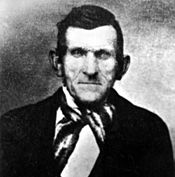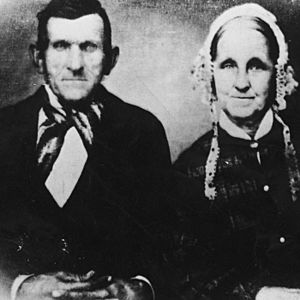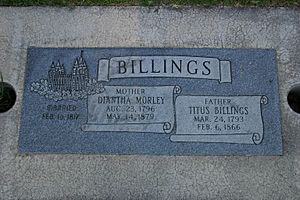Titus Billings facts for kids
Quick facts for kids Titus Billings |
|
|---|---|
 |
|
| Second Counselor to the Bishop of the Church | |
| August 1, 1837 – May 27, 1840 | |
| End reason | Honorably released at the death of Edward Partridge |
| Personal details | |
| Born | March 25, 1793 Greenfield, Massachusetts, United States |
| Died | February 6, 1866 (aged 72) Provo, Utah Territory, United States |
| Resting place | Provo City Cemetery 40°13′30″N 111°38′40″W / 40.225°N 111.6444°W |
| Spouse(s) | Mary Ann Tuttle Diantha Morley |
| Children | 13 |
Titus Billings (born March 25, 1793, died February 6, 1866) was an important early member of the Latter Day Saint movement. He worked closely with leaders like Joseph Smith and Brigham Young. Titus Billings held many important roles in the church. He was a counselor to the first Bishop, Edward Partridge. He also served as a colonel in the Nauvoo Legion and helped lead groups of Mormon pioneers to Utah. He was a key founder of Manti, Utah.
Contents
Early Life and Family
Titus Billings was born in Greenfield, Massachusetts, on March 24, 1793. His parents were Ebeneezer Billings and Ester Joyce. A famous ancestor was Sir Thomas Billing, who was a Chief Justice in England.
Joining a New Community
On February 16, 1817, Titus married Diantha Morley. Diantha and her older brother, Isaac Morley, were part of Sidney Rigdon's church group. This group believed in sharing everything they owned. They also believed in bringing back a purer form of Christianity, like the early Christian church. These ideas helped prepare Titus for his future in the Church of Christ, which is what The Church of Jesus Christ of Latter-day Saints was first called.
In November 1830, Sidney Rigdon joined the new Church of Christ. He gave a long talk explaining his decision. The next morning, Titus Billings was the second person baptized in Kirtland, Ohio.
Early Church Service
In March 1831, Joseph Smith said he received a message for church members. It asked them to share their land and money with the church. In August 1831, Titus was asked to sell the Morley family farm. This was to prepare for a move to Independence, Missouri.
On March 10, 1832, Titus was ordained an elder. While traveling to Missouri, he met Joseph Smith on a steamboat. The Billings family arrived in Clay County, Missouri, in May.
Challenges in Missouri
In Missouri, Titus Billings joined the United Order. This was a group where members shared their goods. However, this group did not last long. People who were against the Latter Day Saints caused problems. Titus lost much of his property. A mob burned his hay and forced him out of Clay County.
In February 1835, Titus and Diantha were asked to return to Kirtland. They helped finish the Kirtland Temple. Titus was a stonemason, carpenter, and musician. Diantha designed the first temple clothing. When the temple was finished, Diantha sang at the dedication. Titus joined the School of the Prophets.
The Billings family moved back to Missouri in 1837. Titus became a counselor to Bishop Edward Partridge. He served in this role until Bishop Partridge died in 1840.
Facing Persecution
On October 25, 1838, Titus Billings was part of the Battle of Crooked River. After the battle, he had to flee his home. He suffered from hunger and frostbite on his feet. As a result of the conflict, the governor signed an order against the Latter Day Saints. Titus signed a paper listing the property he lost, which was never returned.
To escape the mobs, Titus and his family moved to Morleytown. This town was near modern-day Lima, Illinois, and close to Nauvoo, Illinois.
Service in Nauvoo
In February 1841, the Nauvoo Legion was formed. Titus Billings became a captain. By September, he was promoted to colonel in the legion.
In August 1842, Titus was called to serve a mission in the New England states. He returned in June 1843.
In September 1846, Isaac Morley's shop was burned. The Billings family and others moved to Nauvoo. Titus worked on the Nauvoo Temple every day until it was finished. But because of continued pressure from mobs, their stay in Nauvoo was short. After Joseph Smith's death, the Billings family and other members left Nauvoo.
In 1848, Titus Billings was a Captain of Fifty in Heber C. Kimball's pioneer company. They arrived in the Salt Lake Valley in the winter of 1848. In February 1849, Titus was called to serve on the High Council in Salt Lake City.
Settling in Utah
A Native American leader named Walkara invited Brigham Young to send settlers to central Utah. Brigham Young sent Isaac Morley and other settlers, including the Titus Billings family, to what is now Manti, Utah. Manti was officially made a city in 1851.
After the area was surveyed, the settlers moved from their temporary homes. They built new houses on their city lots. Titus Billings and Jezreel Shomaker built the first houses. The Billings home still stands today. Titus lived in Manti and served in the Stake presidency there in 1851.
Helping Native American Children
At first, the local Native American tribes were friendly with the settlers. However, they were at war with each other. When one tribe won a battle, they sometimes took the women and children of the other tribe as slaves. The pioneers saw how cruelly these children were treated. Sometimes, they would buy the children from their captors to free them. Titus Billings bought a young Native American girl. He gave her to Diantha to raise as their daughter. Diantha named the girl Rose Billings. After some years, the pioneers helped the tribes understand that their cruelty was wrong. The practice of taking slaves gradually stopped.
Family Life
On January 20, 1854, Titus Billings married Mary Ann Tuttle. This was part of the practice of plural marriage at the time. Mary Ann had four children with Titus before they later separated.
Later Years and Death
In his later years, Titus Billings moved to Provo, Utah. He died there at the age of 72 on February 6, 1866. He is buried in the Provo City Cemetery with his first wife, Diantha.
His Children
Children from Diantha Morley Billings:
- Samuel Dwight Billings
- Thomas Billings
- Ebenezer Billings
- Emily Billings
- Martha Billings
- Alfred Nelson Billings
- George Pierce Billings
- Eunice Billings
- Titus Billings (Jr.)
Children from Mary Ann Tuttle:
- Emily Billings
- Titus Billings (Jr.)
- Theresa Billings
- Alonzo Billings



